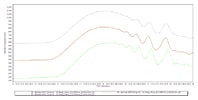Access Agilent eNewsletter September 2015
>> Update My Profile | Subscribe to Access Agilent | Article Directory

GPC/SEC miniaturization delivers lower solvent costs, higher throughput, and excellent separations
By Stephen Luke, Peter Cooke, and Graham Cleaver
Agilent GPC
Gel permeation/size exclusion chromatography (GPC/SEC) is an important liquid chromatographic technique for determining molecular weight distribution and averages of a polymer, and for comparing batch-to-batch polymer quality. Miniaturization – the use of smaller column dimensions – has been a popular approach in many LC techniques. Benefits of miniaturization include reduced solvent costs, higher throughput, increased detector response, and the ability to take full advantage of the latest advances in LC instrument design, as highlighted in Table 1.
Parameter |
Change |
Benefit |
Consideration |
|---|---|---|---|
|
Flow rate |
Lower |
Less solvent |
Pump flow rate precision |
|
Peak volume |
Lower |
More sensitivity |
System dispersion volume |
|
Peak width |
Narrower |
Higher resolution |
Detector data sampling rate |
Table 1. Benefits of GPC/SEC miniaturization.
To demonstrate these benefits in detail, we analyzed polystyrene and epoxy resin samples with GPC columns that resolve numerous oligomer peaks. This approach let us take full advantage of new options provided by high performance GPC/SEC columns, new column formats, and the latest advances in LC instruments. We used an Agilent 1260 Infinity GPC/SEC system with an Agilent 1290 Infinity II Refractive Index Detector (RID).
Ideal for GPC/SEC applications where run-to-run and day-to-day precision of retention times is important, the Agilent 1260 Infinity Isocratic Pump features virtually pulse-free and stable solvent flow.
The Agilent1290 Infinity II RID is optimized for use with fast separations on narrow internal diameter columns, optimized fluidic connections, 2.1 µL flow cell volume, and a maximum data rate of 148 Hz.
In this test, data were collected and processed using Agilent GPC/SEC software version 1.2.
 Enlarge
Enlarge
Figure 1. PS 580 run on two Agilent OligoPore, 4.6 x 250 mm columns at 0.3 (bottom trace), 0.6 (middle trace), and 1.2 mL/min (top trace). Normalized retention time.
 Enlarge
Enlarge
Figure 2. Epikote 1004 run on two Agilent MesoPore, 2.1 x 250 mm columns at 0.06 (bottom trace), 0.12 (middle trace), and 0.24 mL/min (top trace). Normalized run time.
 Enlarge
Enlarge
Figure 3. PS 580 run six times on two Agilent OligoPore, 2.1 x 250 mm columns at 0.06 mL/min.
Increased resolution with high-performance Agilent GPC columns
High-performance columns that deliver significantly increased resolution, compared to a conventional GPC/SEC column set, allow the use of fewer columns in series and higher linear velocities without sacrificing separation quality. To investigate how fast miniaturized GPC/SEC separations can be, each sample was run at three different flow rates, from the normal linear velocity (equivalent to 1.0 mL/minute on a 7.5 mm id column) to 4x this flow (Figure 1).
Excellent oligomeric resolution for a PS 580 sample was achieved by using two Agilent OligoPore, 4.6 x 250 mm, columns. Resolution was largely maintained at the 1.2 mL/min flow rate, where run time was less than six minutes.
Further miniaturization and faster separations with Agilent MesoPore columns
We also investigated outcomes of further miniaturization using even narrower internal diameter columns. Two Agilent MesoPore, 2.1 x 250 mm columns gave excellent resolution for oligomers in epoxy resin samples. Again, resolution was largely maintained at the highest flow rate with a run time of less than six minutes (Figure 2).
Use less solvent with Agilent GPC/SEC columns
The lower flow rate required for GPC/SEC columns with an internal diameter of 4.6 mm gives a 70% saving in solvent consumption compared to 7.5 mm id. If the column internal diameter is reduced to 2.1 mm, this saving becomes 94%. As is the case with UHPLC, using 2.1 mm id columns requires careful control of system dispersion, including the detector flow cell volume.
Reproducible and reliable results with Agilent OligoPore columns
Reproducible retention times are critical for accurate and reliable GPC/SEC. Even at the lowest flow rate of 0.06 mL/min, two Agilent OligoPore, 2.1 x 250 mm columns delivered retention time precision of 0.04% RSD (Figure 3).
Easy method transfer with Agilent GPC/SEC
The PS/DVB particles packed in Agilent OligoPore and Agilent MesoPore high-performance columns are a proven technology for GPC/SEC. This means that methods can be transferred with confidence without the risk of absorbance effects or other interactions between the analytes and stationary phase.
While GPC/SEC miniaturization does require careful control of the system dispersion volume, a feature of UHPLC instruments, it does not require the very high-pressures that these instruments are designed to support. Pressures generated by the different column/flow rate combinations were all well within the 600 bar pressure limit of the Agilent 1260 Infinity GPC/SEC system.
With a low volume detector flow cell and high detector data rate, miniaturized high performance Agilent GPC/SEC columns generate excellent resolution and fast run times. What’s more, miniaturization of high performance GPC/SEC columns with a 2.1 mm internal diameter reduces solvent consumption by 94% compared to 7.5 mm columns.
Accelerate decision times with Agilent GPC/SEC
Reliable analyses of polymer manufacturing materials are vital to ensure product performance. Due to the importance of efficiency and cost-effectiveness, it is essential to run accurate analytical processes that can quickly ascertain quality. The Agilent GPC/SEC portfolio includes market-leading instrumentation, columns, standards, and data analysis software for polymer analysis. Our industry-leading HPLC systems accelerate decision times in batch testing with accurate molecular weight information. Contact an Agilent Representative today to find out how Agilent GPC/SEC and HPLC solutions can help your busy lab.
>> Update My Profile | Subscribe to Access Agilent | Article Directory
Figure 1.

|
Column |
4.6 x 250 mm |
2.1 x 250 mm |
Run time |
|
Mobile phase |
THF |
||
|
Flow rate |
0.3 mL/min |
0.06 mL/min |
24 minutes |
|
Sample conc |
1 mg/mL |
|
|
|
Inj volume |
2 µL |
0.5 µL |
|
|
Temperature |
50 °C |
|
|
PS 580 run on two Agilent OligoPore, 4.6 x 250 mm columns at 0.3 (bottom trace), 0.6 (middle trace), and 1.2 mL/min (top trace). Normalized retention time.

